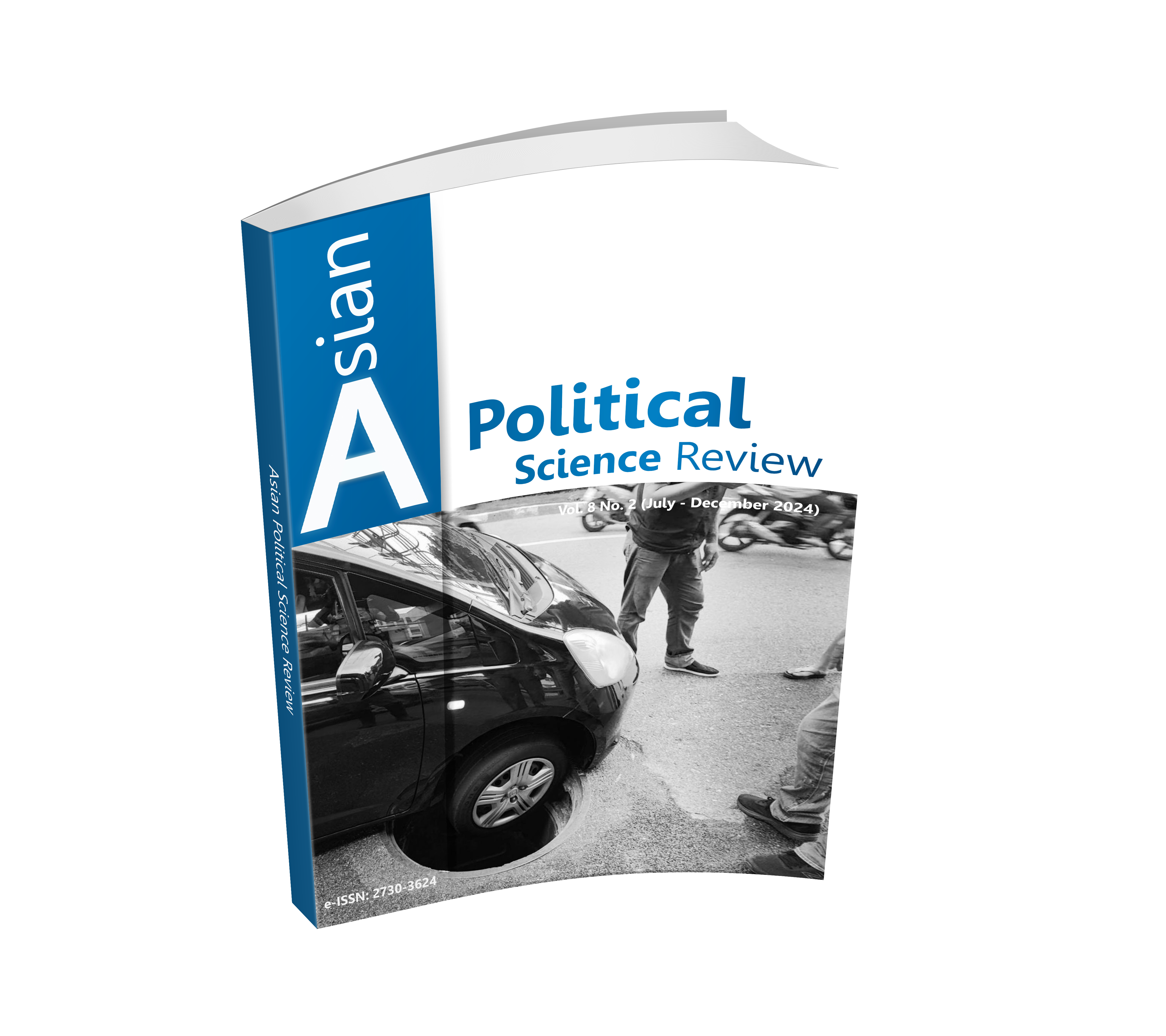SECURITIZATION AND COUNTER-SECURITIZATION OF MILITANCY IN PAKISTAN AFTER 9/11
DOI:
https://doi.org/10.14456/apsr.2024.17Keywords:
Securitization, Counter-Securitization, Pakistan, Militancy, Post-9/11Abstract
The article attempts to explore the securitization of militancy of General Pervez Musharraf government (1999-2008) after the US War on Terror in Pakistan. This article addresses the fundamental question whether Musharraf government succeeded to securitize militancy and whether the audience (public) accepted militancy as a threat or not? We argue that the audience did not accept the threat as such and the issue was counter-securitized. We analyse the speeches of different leaders of the political and religious parties where they through speech acts counter-securitized the issue of militancy. The study contributes to the theoretical discussion on securitisation and counter-securitization using the model in Pakistan. The study contributes to the empirical literature by analysing militancy in Pakistan after 9/11 in the light of securitization framework.
Downloads
References
Abbas, H. (2015). Pakistan’s Drift into Extremism: Allah, the Army and America’s War on Terror. London: Routledge.
Abbas, H. (2016). Confronting Extremism Through Building an Effective Counter-Narrative: The Role of Political Parties and Law Enforcement Agencies in Pakistan. Islamabad: United Nations Development Programme Pakistan.
Afzal, M. (2018). Pakistan Under Siege: Extremism, Society and the State. Washington, D.C.: Brookings Institution Press.
Ahmed, A. (2013). The Thistle and Drones, War against Terror or War against Tribal Islam. Washington D.C.: Brookings Institution Press.
Ahmed, I. (ed.). (2011). The Politics of Religion in South and Southeast Asia. London: Routledge.
Ahmed, I. (2013). Pakistan A Garrison State: Origins, Evolution, Consequences 1947-2011. Oxford: Oxford University Press.
Balzacq, T. (2008). The policy tools of securitization: Information exchange, EU foreign and interior policies. Journal of Common Market Studies, 46(1), 75-100.
Balzacq, T. (2011). A theory of securitization: Origins, core assumptions and variants. In T. Balzacq. (ed.). Securitization Theory: How security problems emerge and dissolve (pp. 1-29). London: Routledge.
Beall, C., & Clark, R. (2021). A “Post-Copenhagen” Analysis of China’s Securitization of the Uyghur: A Counterproductive Securitization?. Democracy and Security, 17(4), 427-454.
Bijl, E., & Borgh, C. (2022). Securitization of Muslims in Myanmar’s Early Transition (2010-15). Nationalism and Ethnic Politics, 28(2), 105-124.
Buzan, B., Wilde, J., & Wæver, O. (1998). Security: A New Framework of Analysis. London: Lynne Rienner.
CNN. (2010). Muslim scholar’s fatwa condemns terrorism. Retrieved from https://edition.cnn.com/2010/WORLD/europe/03/03/fatwa.against.terror/index.html.
Durrani, A. (2018). Pakistan Adrift: Navigating Troubled Waters. London: C. Hurst & Co, Publishers Ltd.
Emmers, R. (2013). “Securitization”, in Alan Collins, Contemporary Security Studies. Oxford: Oxford University Press.
Feyyaz, M. (2015). Why Pakistan Does Not Have a Counterterrorism Narrative. Journal of Strategic Security, 8(1), 63-78.
Fridolfssona, C., & Elander, I. (2021). Between Securitization and Counter-Securitization: Church of Sweden Opposing the Turn of Swedish Government Migration Policy. Politics, Religion & Ideology, 22(1), 40-63.
Fumagalli, M. (2010). Islamic radicalism and the insecurity dilemma in Central Asia: The role of Russia. In O. Dannreuther, & L. March. (eds.). Russia and Islam: State, Society and Radicalism (pp. 191-208). London: Routledge.
Gregory, S., & Revill, J. (2008). The role of the military in the cohesion and stability of Pakistan. Contemporary South Asia, 16(1), 39-61.
Gul, I. (ed.). (2008). Pakistan’s Reverse Revolution. Washington, D.C.: Middle East Institute.
Gul, S., & Royal, K. (2006). Burning The Barn to Roast the Pig? Proportionality Concerns in the War on Terror and the Damadola Incident. Willamette Journal of International Law and Dispute Resolution, 14(1), 49-72.
Haleem, A. (2005). The Qur’an Translated. Oxford: Oxford University Press.
Haqqani, H. (2005). Pakistan: Between Mosque and Military. Washington D.C.: Carnegie Endowment for International Peace.
Hintjens, H. (2019). Failed Securitization Moves during the 2015 Migration Crisis. International Organisation for Migration, 57(4), 181-196.
Hoti, J. (2010). Moderate scholar Dr Farooq killed in Mardan. Retrieved from www.dawn.com/news/567585/moderate-scholar-dr-farooq-killed-in-mardan.
Hussain, S., & Malik, M. (2014). Political Instability and Its Implications for an Effective National. In M. Yusuf. (ed.). Pakistan’s Counterterrorism Challenge (pp. 83-102). Washington, D.C.: Georgetown University Press.
Huysmans, J. (1998). Security! What do you mean? From Concept to thick Signifier. European Journal of International Law, 4(2), 226-255.
Huysmans, J. (2000). The European Union and the Securitization of Migration. Journal of Common Market Studies, 38(5), 751-777.
Iqbal, K., Zafar, S., & Mehmood, Z. (2019) Critical evaluation of Pakistan’s counter-narrative efforts. Journal of Policing, Intelligence and Counter Terrorism, 14(2),147-163.
Kam, S., & Clarke, M. (2021). Securitization, surveillance and ‘de-extremization’ in Xinjiang. International Affairs, 97(3), 625-642.
Karyotis, G., & Patrikios, S. (2010). Religion, Securitization and anti-immigration attitudes: the case of Greece. Journal of Peace Research, 47(1), 43-57.
Kaunert, C., & Ezeokafor, E. (2022). Securitization outside the West: African Security reconceptualised. London: Routledge.
Khan, A. (2013). Pakistan and the Narratives of Extremism. Retrieved from www.humanitarianlibrary.org/sites/default/files/2014/02/SR327-Pakistan-and-the-Narratives-of-Extremism_0.pdf.
Khan, A., & Kaunert, C. (2023). US drone strikes, securitization processes and practices: A case study of Pakistan. Critical Studies on Terrorism, 16(2), 287-304.
Khan, I. (2011). Imran Khan: A Personal History. London: Bantam Press.
Leonard, S. (2010). EU border security and migration into the European Union: FRONTEX and securitisation through practices. European Security, 19(2), 231-254.
Lim, G. (2018). SECURITIZE/COUNTER-SECURITIZE: The Life and Death of Malaysia’s Anti-Fake News Act. Retrieved from https://datasociety.net/library/securitize-counter-securitize/.
Murphy, E., & Malik, A. (2009). Pakistan Jihad: The Making of Religious Terrorism. IPRI Journal, 9(2), 17-31.
Musharraf, P. (2006). In the Line of Fire. London: Simon and Schuster.
Neo, R. (2022). Securitisation of the President: Trump as a national security threat. Cambridge Review of International Affairs, 35(6), 846-867.
Perlez, J. (2008). Pakistani Legislators Show Little Appetite for a Fight. Retrieved from www.nytimes.com/2008/10/21/world/asia/21pstan.html.
Qazi, S. (2011). Rebels of the frontier: origins, organisation, and recruitment of the Pakistani Taliban. Small Wars & Insurgencies, 22(4), 574-602.
Rana, M. (2009). Taliban Insurgency in Pakistan: A Counterinsurgency Perspective. Retrieved from www.pakpips.com/article/1485.
Rashid, A. (2008). Descent into Chaos: The United States and Failure of Nation Building in Pakistan, Afghanistan and Central Asia. New York: Viking Penguin Group.
Razarwal, A. (2003). No terrorist hiding in FATA: Claims Mehmood. Islamabad: The Frontier Post.
Researchers of Islamic Research Institute. (2018). Paigham-e-Pakistan. Islamabad: Islamic Research Institute Press.
Ruzicka, J. (2019). Failed Securitization: Why It Matters. Polity, 51(2), 1-13.
Sahar, A., & Kaunert, C. (2021). Desecuritisation, deradicalisation, and national identity in Afghanistan: Higher education and desecuritisation processes. European Journal of International Security, 1-18. doi:10.1017/eis.2021.31.
Sajjad, F. (2015). Countering Extremists’ Narrative in Pakistan. NDU Journal, 29, 75-94.
Salter, M. (2011). When securitization fails the hard case of counter-terrorism programs. In T. Balzacq. (ed). Securitization Theory How security problems emerge and dissolve (pp. 116-131). London: Routledge.
Siddiqa, A. (2011). Pakistan’s Counterterrorism Strategy: Separating Friends from Enemies. The Washington Quarterly, 34(1), 149-162.
Stritzel, H., & Chang, S. (2015). Securitization and Counter-securitization in Afghanistan. Security Dialogue, 46(6), 548-567.
Šuloviḉ, V. (2010). Meaning of Security and Theory of Securitization. Belgrade: Belgrade Center for Security Study.
The Frontier Post. (2002). Fazl terms US operations against war on peace. Islamabad: The Frontier Post.
The Frontier Post. (2003a). Countrywide protest rallies condemn US. Islamabad: The Frontier Post.
The Frontier Post. (2003b). Combined opposition warns of movement in FATA. Islamabad: The Frontier Post.
The Frontier Post. (2004a). Wana Operation termed conspiracy against tribal. Islamabad: The Frontier Post.
The Frontier Post. (2004b). Rulers to pay for Wana bloodshed, says ANP. Islamabad: The Frontier Post.
The Frontier Post. (2004c). Imran for probe into FATA killings. Islamabad: The Frontier Post.
The Frontier Post. (2004e). Nek Muhammad vowed to fight till death. Islamabad: The Frontier Post.
The Frontier Post. (2004f). No Foreign Terrorists in South Waziristan Agency: Fazl. Islamabad: The Frontier Post.
The Frontier Post. (2004g). Wana drive is for safeguarding US interests, alleges Fahim. Islamabad: The Frontier Post.
The Frontier Post. (2005). NWA test ground for US weapon: Siraj. Islamabad: The Frontier Post.
The Frontier Post. (2006). Tribesmen hold rally against US strikes. Islamabad: The Frontier Post.
The Nation. (2016). Pakistan Ulema Council issues fatwa against ISIS. Retrieved from https://nation.com.pk/11-May-2016/pakistan-ulema-council-issues-fatwa-against-isis.
The Tribune. (2013). Anyone killed by US is a ‘martyr’: Fazlur Rehman. Retrieved from https://tribune.com.pk/story/627393/anyone-killed-by-us-is-a-martyr-fazlur-rehman/.
Vuori, J. (2008). Illocutionary Logic and Strands of Securitization: Applying the Theory of Securitization to the Study of Non-Democratic Political Orders. European Journal of International Relations, 14(1), 65-99.
Vuori, J. (2011). HOW TO DO SECURITY WITH WORDS: A Grammar of Securitisation in the People’s Republic of China. Academic Dissertation, University of Turku.
Watson, S. (2009). The Securitization of Humanitarian Migration: Digging Moats and Sinking Boats. London: Routledge.
Watson, S. (2012). ‘Framing’ the Copenhagen School: Integrating the Literature on Threat Construction. Journal of International Studies, 40(2), 279-301.
Wilkinson, C. (2007). The Copenhagen School on Tour in Kyrgyzstan: Is Securitization Theory Useable Outside Europe?. Security Dialogue, 38(1), 5-25.
Yousafzai, A. (2003). NWFP MPs want operation halted. Islamabad: The Frontier Post.
Zaman, M. (2018). Islam in Pakistan: A History. New Jersey: Princeton University Press.

Downloads
Published
How to Cite
Issue
Section
License
Copyright (c) 2024 Authors

This work is licensed under a Creative Commons Attribution-NonCommercial-NoDerivatives 4.0 International License.











.png)


